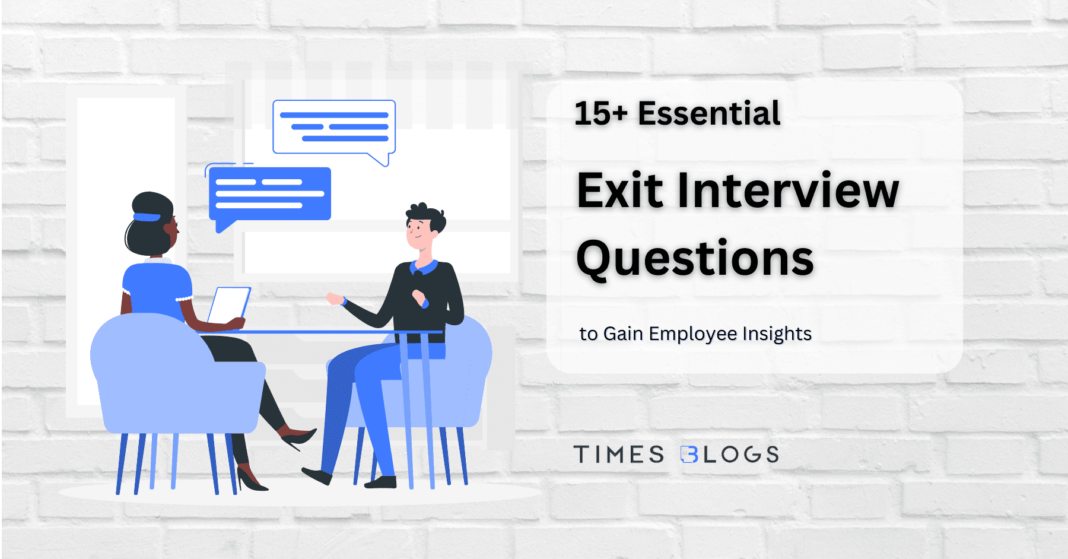In the tapestry of organizational dynamics, there’s a thread that’s often subtle yet immensely revealing: feedback. When an employee stands at the crossroads of departure, it’s more than just the turn of a page. It’s a chance to delve into a chapter brimming with insights, lessons, and possibilities. Exit interview questions stand at the heart of this chapter, weaving together narratives that can transform an organization’s very fabric.
For curious-minded leaders, HR aficionados, and every team member in between, the parting of a colleague often raises a silent query: What nudged them toward a new horizon? Was it the siren call of fresh challenges, a shift in life’s personal tapestry, or perhaps an unspoken echo of areas we might need to re-evaluate? This is the allure of expertly framed exit interview questions. Picture it as a fireside chat, an exchange that traverses the peaks of achievements, the valleys of challenges, and the meandering paths of potential improvements.
So, let’s embark on this journey, charting the intricate landscape of exit interviews. Together, we’ll navigate through 15+ essential exit interview questions, each meticulously designed to offer more than just answers. They serve as windows, revealing vistas that have the power to sculpt a harmonious, vibrant, and thriving workplace.
Table of Contents
The Importance of Exit Interview Questions in the Corporate Landscape
Exit interview questions are more than just a series of inquiries—they’re a strategic tool that carries immense weight in a company’s evolution and development. Delving into their significance, here are some paramount reasons highlighting the importance of these questions:
- Feedback Mechanism: Through exit interview questions, departing employees offer an unvarnished view of the organization’s inner workings, culture, and possible friction points. Their responses to these questions can illuminate facets of the company often missed in regular reviews.
- Identify Areas of Improvement: The insights gathered from exit interview questions can spotlight precise areas in need of enhancement, be it nuances in management techniques, team dynamics, resource provision, or even the design of job roles.
- Reduction in Turnover: Grasping the core reasons that prompt an employee’s exit is pivotal. Exit interview questions pave the way to such comprehension, enabling companies to address underlying concerns, thereby slashing turnover rates and the financial strains attached.
- Enhance Retention Strategies: The feedback procured from exit interview questions stands as a guide for HR mavens and leaders. With it, they can refine and recalibrate retention blueprints, discerning the elements that resonate and those that falter.
- Understanding the External Market: As employees often set sail towards other professional shores, the answers to exit interview questions can divulge what competing entities offer. Such insights are invaluable in ensuring a business remains at the forefront in the talent attraction game.
- Closure for Employees: Beyond the organizational gains, exit interview questions furnish a formal stage for outgoing team members. It’s a space where they can candidly discuss their journey, voice grievances, and offer parting wisdom, ensuring a sense of closure as they step into new chapters.

The Objectives of Crafting Comprehensive Exit Interview Questions
Crafting purposeful exit interview questions is more than a customary exercise; it’s a strategic endeavor. The rationale behind each question is layered with objectives, driving the direction and depth of the conversation while shaping subsequent actions based on the revelations.
- Uncover Root Causes: A fundamental objective of exit interview questions is to delve into the core reasons that catalyzed an employee’s choice to move on. By doing so, organizations can target and address these specific catalysts.
- Understand Employee Satisfaction: Exit interview questions strive to tap into the outgoing employee’s sentiment towards the organization. They probe into satisfaction levels concerning diverse segments – from the intricacies of job responsibilities and team camaraderie to the nuances of leadership and organizational ethos.
- Gather Constructive Feedback: While feedback during tenure might occasionally tread on eggshells, exit interview questions pave the path for raw, unfiltered, and constructive insights. Such revelations, when embraced, can be a lighthouse for organizational refinement.
- Highlight Positives: Far from being solely corrective, exit interview questions also seek the silver linings. By discerning what resonated positively with the departing individual, companies can amplify and replicate these successful strategies.
- Identify Training and Development Gaps: These questions can be insightful, revealing if the employee felt their skillset was adequately nurtured and augmented, hinting at potential revamps in training modules and growth opportunities.
- Assess Company Reputation: Gauging how a departing employee perceives and will represent the company in the future, exit interview questions offer a glimpse into the organization’s perceived reputation in the broader industry landscape.
- Facilitate Smooth Transitions: On a more immediate operational note, exit interview questions delve into the nitty-gritty of the employee’s current projects, obligations, and handovers. This ensures that their successor inherits a clear roadmap.
In summation, exit interview questions are not a mere formality. They are strategic tools with multi-pronged objectives. Each query is calibrated to extract insights spanning the breadth and depth of an individual’s journey, rendering perspectives that can fortify and rejuvenate the workplace ambiance.
Exit interview questions are designed with specific objectives in mind. These objectives guide the formulation of the questions and influence the subsequent use of the information obtained.
15 Essential Exit Interview Questions (to Gain Deep Employee Insights)
1. Why did you decide to leave the company?
Explanation:
At the heart of every exit interview lies this primary inquiry. By establishing a non-judgmental and open platform, you allow the departing employee to share their central reasons for leaving. Answers might encompass personal growth, organizational dynamics, career shifts, or personal reasons. This feedback serves as a foundational base for understanding overarching themes behind employee departures.
Real-life example:
Jason, a senior data analyst, shared during his exit interview that his decision to leave was influenced by an offer from another company with a more research-centric role, aligning better with his career aspirations.
2. How did the job match your expectations when you first started?
Explanation:
With this question, you’re delving into the core of the employee’s journey — from their entry into the company to their exit. It explores the alignment of initial job perceptions and actual job responsibilities. The feedback can indicate if there’s a disparity between what’s being portrayed during the hiring phase and the ground reality.
Real-life example:
When Emily began her role as a Product Manager, she anticipated more autonomy in decision-making. However, over time, she realized the hierarchical structure of the organization limited her autonomy, making her feel more like a coordinator than a decision-maker.
3. Can you provide feedback about your manager/supervisor?
Explanation:
Managers and supervisors play pivotal roles in the daily experience of employees. They can be motivators, mentors, and leaders. However, they can also become barriers to growth if their management style doesn’t align with the team’s needs. Constructive feedback regarding supervisors provides an avenue to identify areas of excellence and potential training needs for leadership roles.
Real-life example:
During his exit interview, Raj expressed how his manager, Mrs. Gill, was technically proficient but lacked soft skills. Her feedback often came across as harsh criticism, making team meetings a stressful experience for many.
4. Did you feel that you had the tools and resources needed to do your job effectively?
Explanation:
Every job role requires certain tools, software, or resources to be performed effectively. Whether it’s a salesperson needing the latest CRM software or a developer requiring a high-performance computer, having the right resources can make a world of difference. By asking this question, organizations can identify if they’re technologically behind or if there are gaps in providing essential tools for job roles.
Real-life example:
Clara, a digital illustrator, pointed out during her exit interview that the design software provided by the company was several versions outdated. This limitation restricted her from utilizing advanced features, affecting the quality of her work.

5. How would you describe the company culture? Did it influence your decision to leave?
Explanation:
Company culture encompasses the values, behaviors, and shared vision of an organization. It’s the invisible hand that shapes interactions, workflows, and overall employee satisfaction. Understanding an employee’s perception of the culture offers insights into areas that are thriving and those that might need intervention. If the culture played a role in their departure, it’s crucial to understand why.
Real-life example:
Mike appreciated the company’s emphasis on innovation and its open-door policy. However, he felt that the culture around working late hours, even when not necessary, impacted his work-life balance. This culture of ‘staying late equals working hard’ influenced his decision to seek opportunities elsewhere.
6. Were there any company policies or procedures you found problematic?
Explanation:
Every company has its own set of policies and procedures aimed at ensuring smooth operations. However, sometimes, these procedures may inadvertently cause inefficiencies or frustrations for employees. By posing this question, companies can identify potential red-tape, overly bureaucratic processes, or outdated rules that hinder productivity or employee satisfaction.
Real-life example:
Angela, in her role as a project coordinator, found that the company’s travel reimbursement process was tedious. It required multiple layers of approvals, causing delays and sometimes leading to out-of-pocket expenses for extended periods.
7. Did you feel you were given opportunities for professional growth?
Explanation:
The trajectory of an employee’s growth within a company is a testament to the organization’s commitment to its workforce. Professional development can take the form of training, workshops, seminars, or even opportunities to undertake more challenging roles. Absence or scarcity of such opportunities can make employees feel stagnant or undervalued.
Real-life example:
Karim, a mid-level software developer, felt he wasn’t given enough challenges that would push his boundaries. While he was comfortable in his current role, he was seeking projects that would expose him to emerging technologies, a sentiment echoed during his exit interview.
8. How effective do you think our communication processes are?
Explanation:
Effective communication forms the backbone of any organization, ensuring everyone is aligned towards a shared goal. This not only includes top-down communication from leadership to employees but also horizontal communication among peers and different departments. Gaps or lags in communication can lead to misinformation, feelings of exclusion, or decreased morale.
Real-life example:
Stephanie, a member of the sales team, often felt that promotional campaigns were rolled out without adequate notice to her team. This lack of communication meant they couldn’t effectively communicate these promotions to prospective clients.
9. Would you consider returning to the company in the future?
Explanation:
This question aims to gauge the overall sentiment of the departing employee. A positive response indicates that the departure might be driven by personal reasons or specific circumstances at a particular time, rather than deep-rooted issues with the company itself. It also provides an open door for potential re-hiring, capitalizing on past experience and training.
Real-life example:
Maria, who left due to family reasons and relocation, expressed during her exit interview that she held the company in high regard and would definitely consider a return if circumstances allowed in the future.
10. Were you satisfied with the benefits, compensation, and work-life balance?
Explanation:
This multi-faceted question touches upon key pillars of job satisfaction: remuneration, perks, and personal-professional equilibrium. While competitive pay is essential, benefits such as health coverage, parental leave, or even flexible hours can significantly impact an employee’s overall job contentment.
Real-life example:
Oliver was content with his salary but expressed that the lack of a comprehensive health insurance plan and the expectation to work on weekends impacted his overall satisfaction and well-being.
11. Can you suggest any improvements we can make to enhance our work environment?
Explanation:
This question is an invitation for constructive feedback, allowing employees to provide insights into possible changes that can benefit the broader organization. It underscores the company’s commitment to continuous improvement and values the employee’s perspective as a contributor to positive change.
Real-life example:
During his exit interview, Nathan mentioned that the open office layout, though trendy, often made it hard for him to focus due to constant background noise. He suggested implementing quiet zones or offering noise-cancelling headphones.
12. Were there any unresolved issues or conflicts you’d like to discuss?
Explanation:
Creating a space for employees to discuss unresolved matters can shed light on underlying interpersonal conflicts or systemic issues. Addressing these concerns can prevent them from recurring with other team members in the future.
Real-life example:
Priya revealed that she felt overshadowed in team meetings and her ideas were frequently dismissed without due consideration. She believed this to be a recurring issue for some quieter members of her team.
13. How do you feel about the training and onboarding process?
Explanation:
A company’s onboarding process plays a vital role in shaping the initial experiences of new hires. Proper training sets the tone for an employee’s journey, ensuring they feel equipped and welcomed. Feedback on this aspect can help streamline the integration of future employees.
Real-life example:
Carlos, having worked in several firms before, expressed immense satisfaction with the company’s onboarding program. He felt it was well-structured and appreciated the mentorship program that paired him with a senior colleague during his initial weeks.
14. Is there anything you wished you had known before joining?
Explanation:
This question seeks to uncover any potential gaps in communication or misrepresentations during the recruitment process. It provides insights into aligning the expectations set during interviews with the actual workplace experience.
Real-life example:
Ella, who joined the team as a social media manager, expressed that she wished she had been informed about the requirement to work during weekends to handle live events and campaigns. It was an aspect she wasn’t prepared for, leading to work-life balance challenges.
15. Would you recommend this company to a friend? Why or why not?
Explanation:
The answer to this question can be a powerful testament to the overall experience of an employee. A recommendation indicates positive sentiments towards the organization, while hesitation or a negative response can hint at deeper-rooted issues that may need to be addressed.
Real-life example:
Leo, who decided to leave due to a change in career direction, stated he’d wholeheartedly recommend the company to friends. Despite his departure, he appreciated the supportive work culture and growth opportunities provided during his tenure.

Making the Most from Exit Interview Questions’ Feedback
When employees bid adieu, they bequeath a treasure trove of insights gleaned from their responses to exit interview questions. However, the true worth of this treasure emerges only when meticulously examined and acted upon. Here’s how you can extract the maximum value from the feedback mined from these interviews:
a. Analyze for Patterns:
The potency of exit interview questions lies in their ability to shed light on recurring sentiments. Individual comments offer insight, but it’s the recurring themes that signal broader concerns. Are numerous employees flagging the same managerial hiccup? Are many echoing concerns about subpar training materials? Recognizing these patterns is instrumental in differentiating individual concerns from overarching organizational challenges.
b. Communicate and Collaborate:
The insights from exit interview questions should not be siloed within HR’s vaults. It’s imperative that teams, department heads, and even top-tier executives are in the loop about the reasons propelling employee exits. Regular sessions where feedback is shared and dissected with diverse organizational stakeholders can be a game-changer.
c. Implement Changes Where Necessary:
Responding to the findings from exit interview questions necessitates more than just acknowledgment—it demands action. If the collective voice clamors for an equipment overhaul or software upgrade, it’s prudent to allocate resources for it. If there’s a loud chorus for enhanced work-life balance, perhaps it’s time to mull over flexible schedules or remote work options.
d. Reassess and Iterate:
Transformations driven by feedback from exit interview questions shouldn’t be static. Periodically revisit the outcomes of any newly incorporated strategies. It might be worthwhile to roll out a feedback loop with incumbent staff to sense the ripple effects of these changes.
e. Foster an Open Culture:
Champion a culture where feedback—spurred by exit interview questions or otherwise—is not only encouraged but celebrated. When the workforce witnesses their inputs being cherished and acted upon, it sows the seeds of trust and commitment.
Conclusion
Exit interview questions aren’t mere tick-box exercises. They symbolize an organization’s dedication to understanding its strengths and areas for improvement. As employees prepare to depart, their responses to these questions offer unfiltered insights that can pave the way for meaningful change.
However, merely posing exit interview questions isn’t the endgame. The true merit lies in taking actionable steps based on this feedback. By identifying patterns, initiating necessary changes, and continually reassessing their impact, organizations can enhance their overall employee experience.
In today’s ever-evolving corporate world, adaptability is key. Embracing feedback from exit interview questions, even if critical, highlights an organization’s commitment to growth and excellence. In essence, while understanding the reasons for an exit is vital, harnessing this knowledge for organizational betterment is paramount.
Additional Essential Exit Interview Questions
To further our understanding of an employee’s experience and capture nuances that might go unnoticed, here are five more critical exit interview questions, each accompanied by a brief explanation:
16. How did the organization support your overall well-being and mental health?
Explanation:
In an era where mental health and overall well-being are paramount, it’s crucial to evaluate how a company supports its employees beyond the usual confines of professional growth. This question sheds light on programs, flexibility, or other aspects of the company culture catering to holistic health.
17. Were there clear pathways for career progression and advancement?
Explanation:
Career trajectory often defines an employee’s stay duration in an organization. This query is designed to identify if the company provides transparent and attainable growth opportunities, ensuring that talented individuals don’t leave merely due to perceived stagnation.
18. Did you receive regular feedback about your performance, and was it helpful?
Explanation:
Constructive feedback can be the cornerstone of professional development. Through this question, the company can assess the efficiency, relevance, and regularity of its performance appraisal system, refining it as needed.
19. How would you rate the collaboration and team dynamics within your department or project teams?
Explanation:
Positive team dynamics can significantly influence job satisfaction. This question aims to pinpoint potential challenges in team collaboration, cohesion, and overall dynamics, highlighting areas that might benefit from team-building exercises or conflict resolution.
20. Were the company’s mission and values clear to you, and did they influence your work?
Explanation:
A company’s ethos, represented by its mission and values, guides its operations and culture. Understanding how employees resonate with this ethos helps companies ensure that their guiding principles are not just well-communicated but also deeply integrated into daily operations.




